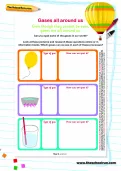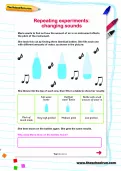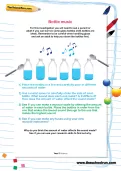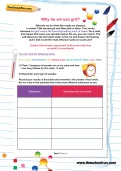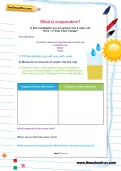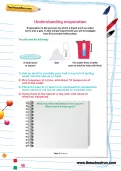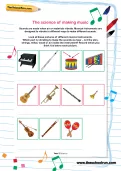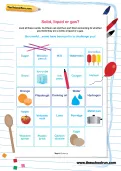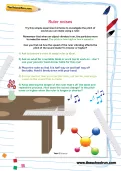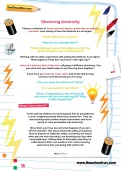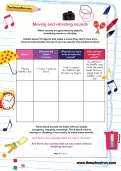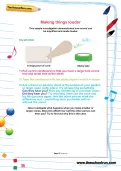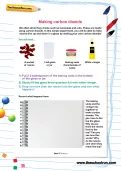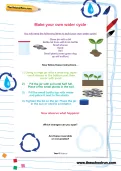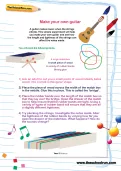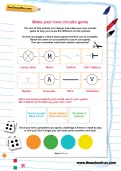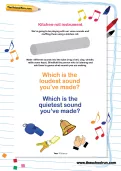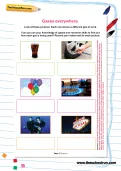Gases are all around us, but they can be hard to spot! Help your child work through this investigation into the gases we can see and what they're used for.
or
Register to add to your saved resources
Already a subscriber? to view this content.
A practical investigation into pitch and how sounds change in different conditions.
or
Register to add to your saved resources
Already a subscriber? to view this content.
For this investigation you will need to ask a parent or adult if you can borrow some glass bottles (milk bottles are ideal). Remember to be careful when handling glass and ask an adult to help you clean the bottles first.
or
Register to add to your saved resources
When the roads are slippery in winter we spread grit and then salt on them. But is salt the most effective solid we could use? Conduct this simple experiment to investigate!
or
Register to add to your saved resources
Already a subscriber? to view this content.
In this investigation you are going to see if water can move – or does it just change?
or
Register to add to your saved resources
Evaporation is the process by which a liquid such as water turns into a gas. In this simple experiment you will investigate how this process takes place.
or
Register to add to your saved resources
Already a subscriber? to view this content.
Look at these pictures of different musical instruments. Which part is vibrating to make the sounds we hear – is it the skin, strings, metal, wood or air inside the instrument? Record which you think it is below each picture.
or
Register to add to your saved resources
Already a subscriber? to view this content.
Look at these cards. Cut them out and then sort them according to whether you think they are a solid, a liquid or a gas. Be careful…some have been put in to challenge you!
or
Register to add to your saved resources
Already a subscriber? to view this content.
Try this simple experiment at home to investigate the pitch of sound you can make using a ruler.
or
Register to add to your saved resources
Already a subscriber? to view this content.
Choose a selection of small electrical objects, preferably two-battery operated. Look closely at how the batteries are arranged. Open up a plug and look at the wires, all going in different directions. Can you work with your adult helper to put the plug back together? If you have an electricity meter clock, look at the dial turning and how much electricity you are using.
or
Register to add to your saved resources
Already a subscriber? to view this content.
When sounds are generated by objects, something moves or vibrates. Collect about 10 objects that make a noise (they don’t have to be musical instruments) and see if you can answer these questions.
or
Register to add to your saved resources
Already a subscriber? to view this content.
This simple investigation demonstrates how sound can be amplified and made louder.
or
Register to add to your saved resources
Already a subscriber? to view this content.
We often drink fizzy drinks such as lemonade and cola. These are made using carbon dioxide. In this simple experiment, you will be able to make raisins dive up and down in a glass by making your own carbon dioxide!
or
Register to add to your saved resources
Already a subscriber? to view this content.
Build your own water cycle and investigate reversible and irreversible changes.
or
Register to add to your saved resources
Already a subscriber? to view this content.
A guitar makes music when the strings vibrate. This simple experiment will help you make your own guitar and see how the length and tightness of the strings can affect the notes made.
or
Register to add to your saved resources
The aim of this activity is to design and make your own circuits game to help you revise the different circuit symbols.
or
Register to add to your saved resources
Already a subscriber? to view this content.
We’re going to be playing with our voice sounds and muffling them using a kitchen roll. Make different sounds into the tube (ring a bell, clap, whistle, rattle some keys). Blindfold the person who is listening and ask them to guess what sounds you are making.
or
Register to add to your saved resources
Can you use your knowledge of gases and research skills to find out how each gas is being used? Record your notes next to each picture.
or
Register to add to your saved resources
Already a subscriber? to view this content.
Look at the cards and diagram. Can you complete the diagram to show the reversible changes of freezing and melting? Don’t forget to label the states of water too!
or
Register to add to your saved resources
Already a subscriber? to view this content.
Evaporation happens all around us. Can you describe what is happening in these pictures? What conditions can make this change happen? What other examples of evaporation can you think of?
or
Register to add to your saved resources
Already a subscriber? to view this content.
